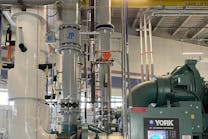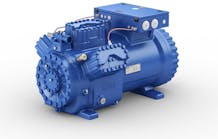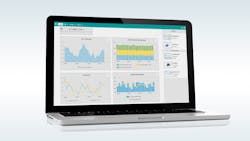By BOB BYROM and JAMIE LEE, Siemens Smart Infrastructure USA
With Americans spending more than 90% of their time indoors, there is an even brighter spotlight now on building health.
Indoor air quality (IAQ) takes center stage, with viruses, bacteria, other pathogens, and even allergens often stealing the show. But carbon dioxide, volatile organic compounds, particulate matter, and temperature and humidity levels also greatly affect occupant comfort, health, and productivity.
Implementing state-of-the-art digital building technologies that detect, measure, and control such factors is key to addressing ongoing environmental and human health challenges within buildings. Smarter, more responsive buildings can use data stored in various building devices and systems, simplify the data, and automate data handling – to help building operators and facility engineers create the safest indoor environment possible.
Critical Data Points to Measure for Building Health
Carbon dioxide (CO2) is a colorless, odorless gas that is a byproduct of normal cell function as well as of combustion. Indoor CO2 levels are typically between 350 and 400 PPM but are recommended to not exceed 1000 PPM. Extended exposure to levels above 1000 PPM can lead to decreased energy and performance. Demand Control Ventilation (DCV) is the most common means of bringing in sufficient outdoor air to dilute high concentrations of CO2. ASHRAE Standard 62.1 helps guide when ventilation is necessary.
Hundreds of volatile organic compounds (VOCs) are in everyday products found throughout buildings: paint, flooring materials, upholstery, and cleaning products. Cosmetics, perfume, and tobacco smoke are VOCs that often accompany people. Being so prevalent, VOCs play a big role in indoor air quality and are usually aggregated as total volatile organic compounds (TVOCs) for ease of measurement. TVOCs rank as the second-most common complaint heard by building managers (with temperature being the first).
While there are no general-purpose standards for TVOCs, the best method of addressing them is by pairing a TVOC sensor with a CO2 sensor and DCV. The TVOC sensor measures common VOCs in aggregate and provides a relative, rather than absolute reading. DCV can be used to address high TVOC levels.
Comprised of small particles suspended in the air for a period of time, particulate matter is the next frontier of indoor air quality. Cooking, construction, fireplaces, machinery, and infiltration/ventilation are indoor sources of particulate matter, while vehicles, industry, power stations, fire, and construction sites are outdoor contributors.
Fine dust particles can measure at PM2.5 (0.3 to 2.5 μm diameter) or at PM10 (0.3 to 10 μm diameter). PM2.5 is of particular concern as it can remain airborne for days or even weeks. It is also small enough to bypass the human body’s natural defense mechanisms and penetrate deep into the lungs. Recent studies indicate viruses could possibly “hitch-hike” onto particulate matter, increasing transmissibility.
There are no published standards for indoor particulate matter levels, so U.S. EPA guidelines for outdoor air are often adjusted accordingly. Enhanced filtering, with a MERV rating between 10 and 12, is typically used to address particulate matter. But to handle PM2.5, a MERV of 14 or above is needed. However, higher MERV ratings will induce a greater pressure drop and may degrade energy efficiency. Reduced airflow could be avoided by using an auxiliary filter when needed. Always consult an HVAC professional before upgrading to filtration with MERV ratings above 12.
Temperature and humidity also play a role in occupant (and building) health. Maintaining indoor relative humidity levels between 40% to 60% can help reduce mold growth and may reduce transmission of colds, flu, and other viruses by as much as 70%. Refer to ASHRAE Standard 55-2017 for more guidance on ideal humidity and temperature settings – they vary by season.
An Open Building Automation System Can Help With Indoor Air Quality
Equally important to understanding, measuring, and controlling the various data points of a building is how they tie into your building automation system (BAS) and it, in turn, “interprets” the data to benefit building operators and occupants. And opening a facility’s BAS can result in better indoor air quality and zone management. Following are some suggested guidelines:
- Promote open communication standards that meet today’s industry guidelines – for example, BACnet, other standards, or even maybe move to open APIs;
- Adopt Haystack or a semantic tagging model to help manage data from various sources and devices;
- Focus on simplicity and ease of use ensuring quick, accessible data;
- Ensure systems allow for complete access from any device, especially tablets and mobile devices;
- Leverage cloud technology to ensure secure, encrypted access.
Total Indoor Air Quality Is More Important Than Ever
As people head back to the office and classrooms, IAQ is taking on more importance. Good IAQ can improve occupant health and productivity, reduce how easily airborne pathogens are spread, and provide peace-of-mind for those returning to highly populated buildings.
Solely relying on occupancy or CO2-based ventilation strategies for accurate IAQ readings are no longer “good enough.” Sensors allow facility engineers to address air quality issues and better manage them.
Connecting these sensors and other building automation systems into an open building automation software platform can provide building operators and facility engineers with better insight into the overall health of their buildings and comfort of occupants.
##########
About the Authors
Bob Byrom is the product manager for sensors at Siemens Smart Infrastructure USA. [email protected].
Jamie Lee is the global product manager for Desigo Optic Software at Siemens Smart Infrastructure USA. [email protected].
Article content reflects what was presented during a 6/23 Siemens webinar. https://attendee.gotowebinar.com/recording/2606623626947661068











